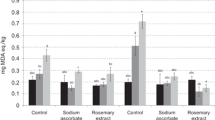Abstract
Rendered pork fat (0.44 water activity, Aw) was subjected to high-pressure treatment of 800 MPa for 20 min at 19°C prior to storage at 4, 25, and 50°C. In all cases, high pressure-treated samples oxidized more rapidly (had a shorter induction period) as shown by the peroxide value (PV), 2-thiobarbituric acid value, and ultraviolet absorbance. The effect was less marked at lower pressures. In contrast, at all water activities outside the range of 0.40–0.55, the PV of the high pressure-treated pork fat was lower than control samples stored similarly, and the PV of rancid fat decreased slightly on pressure treatment at 19°C, but not at higher temperatures. This effect may explain the observed inhibition of oxidation at most water activities. At 0.40–0.55 Aw, other factors, such as the liberation of transition metals, may override the destruction of peroxides.
Similar content being viewed by others
References
Knorr, D.,Food Technol. 6:156 (1993).
Hoover, D.G., Ibid.:150 (1993).
Ohshima, T., T. Nakagawa and C. Koizumi, inSeafood Science and Technology, edited by E.G. Bligh, Fishing News Books, Oxford, 1992, p. 64.
Tanaka, M., Z. Xueyi, Y. Nagashima and T. Taguchi,Nippon Suisan Gakkaishi 57:957 (1991).
Wada, S., inHigh Pressure and Biotechnology, edited by C. Balny, R. Hayashi, K. Heremans and P. Masson, Editions John Libbey Eurotext, Montrouge, 1992, p. 235.
Labuza, T.P.,CRC Crit. Rev. in Food Technol. 2:355 (1971).
Defaye, A.B., D.A. Ledward., D.B. MacDougall and R.F. Tester,Food Chem. 51, in press (1995).
British Standards Methods of Analysis of Fats and Fatty Oils, British Standards Institution, British Standards BS 684, Section 2.14, 1987.
Official Methods and Recommended Practices of the American Oil Chemists’ Society, 4th edn., edited by D. Firestone, American Oil Chemists’ Society, Champaign, 1990, Method Cd 19-90.
British Standards Methods of Analysis of Fats and Fatty Oils, British Standards Institution, British Standards BS 684, Section 1.15, 1990.
Gutierrez-Lopez, G.F., Convective Drying and Solid-Moisture Interactions, Ph.D. Thesis, University of Reading, 1989.
Snedecor, G.W., and W.G. Cochran, inStatistical Methods, 5th edn., The Iowa State University Press, Ames, 1956.
Pearson, D.,The Chemical Analysis of Foods, 7th edn., Edinburgh: Churchill Livingstone, 1976, p. 488.
Nawar, W.W., inFood Chemistry, edited by W.R. Fennema, Marcel Dekker Inc., New York, 1985, p. 139.
Author information
Authors and Affiliations
About this article
Cite this article
Cheah, P.B., Ledward, D.A. High-pressure effects on lipid oxidation. J Am Oil Chem Soc 72, 1059–1063 (1995). https://doi.org/10.1007/BF02660722
Received:
Accepted:
Issue Date:
DOI: https://doi.org/10.1007/BF02660722




